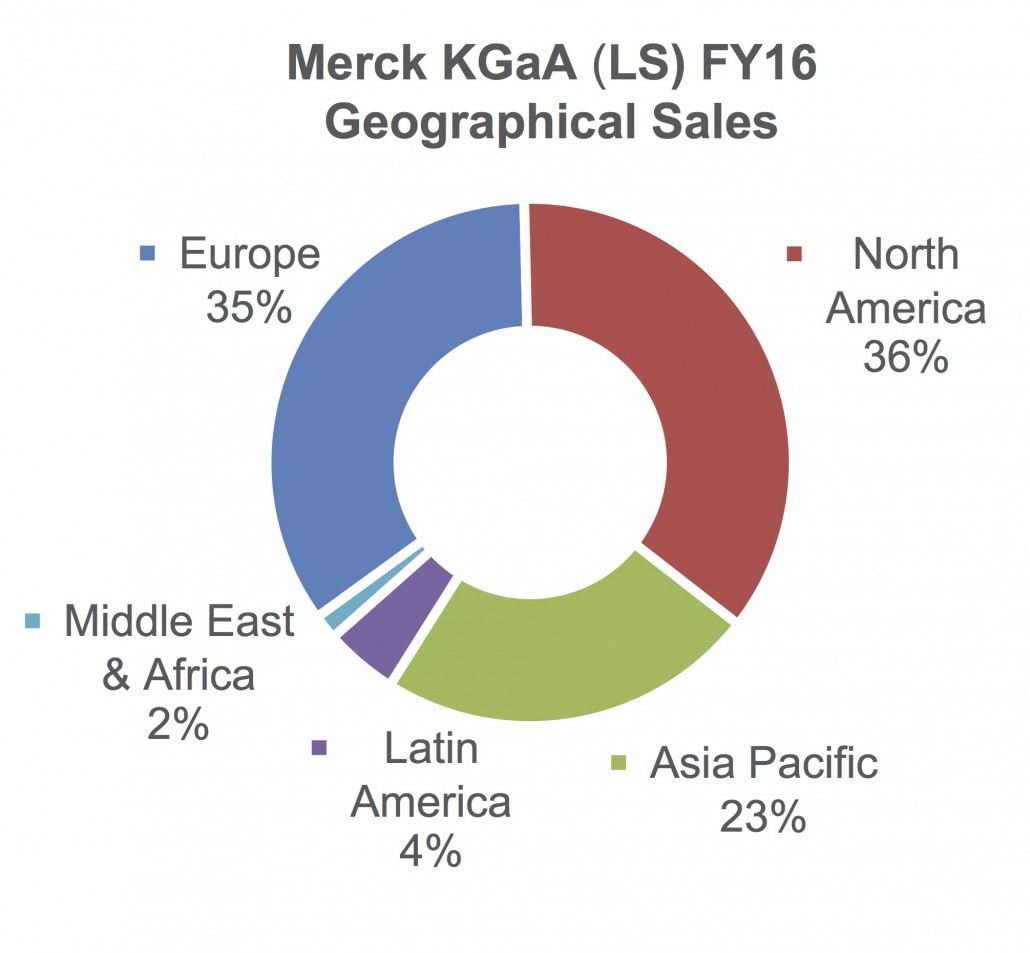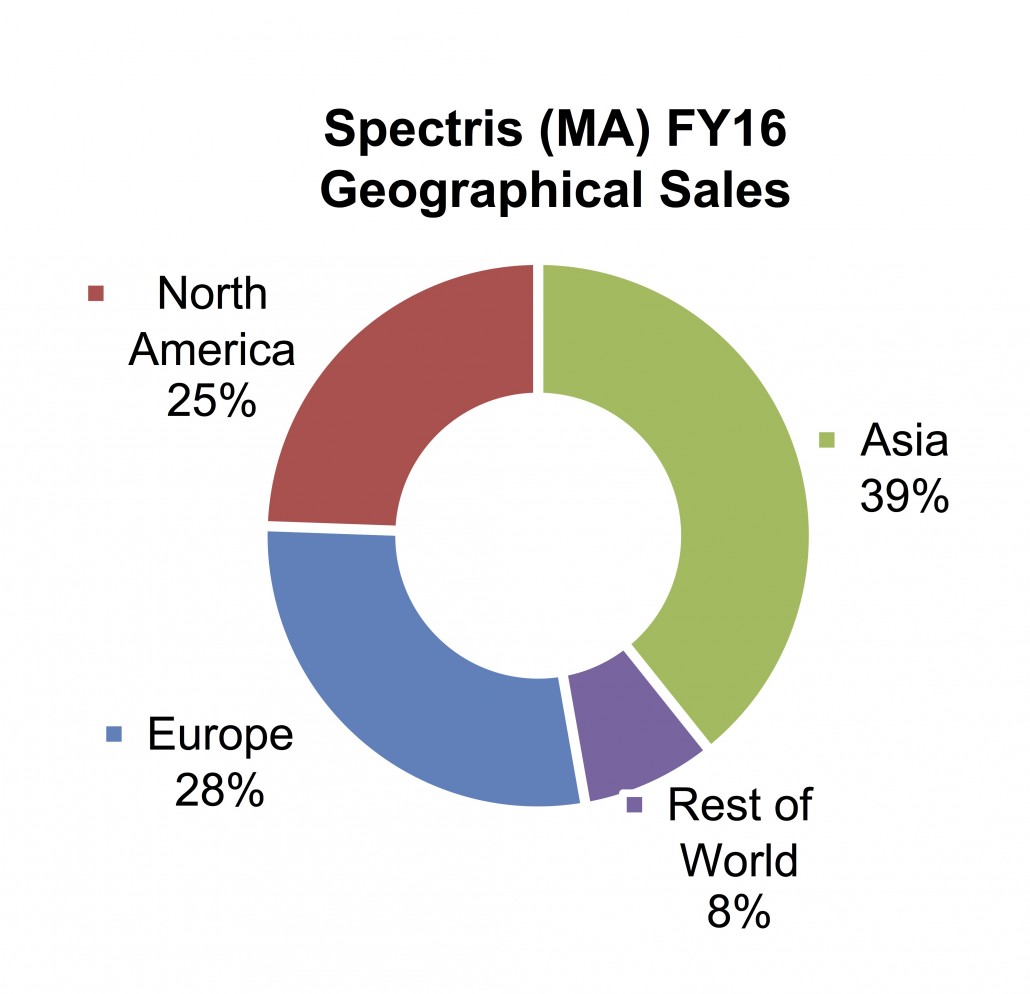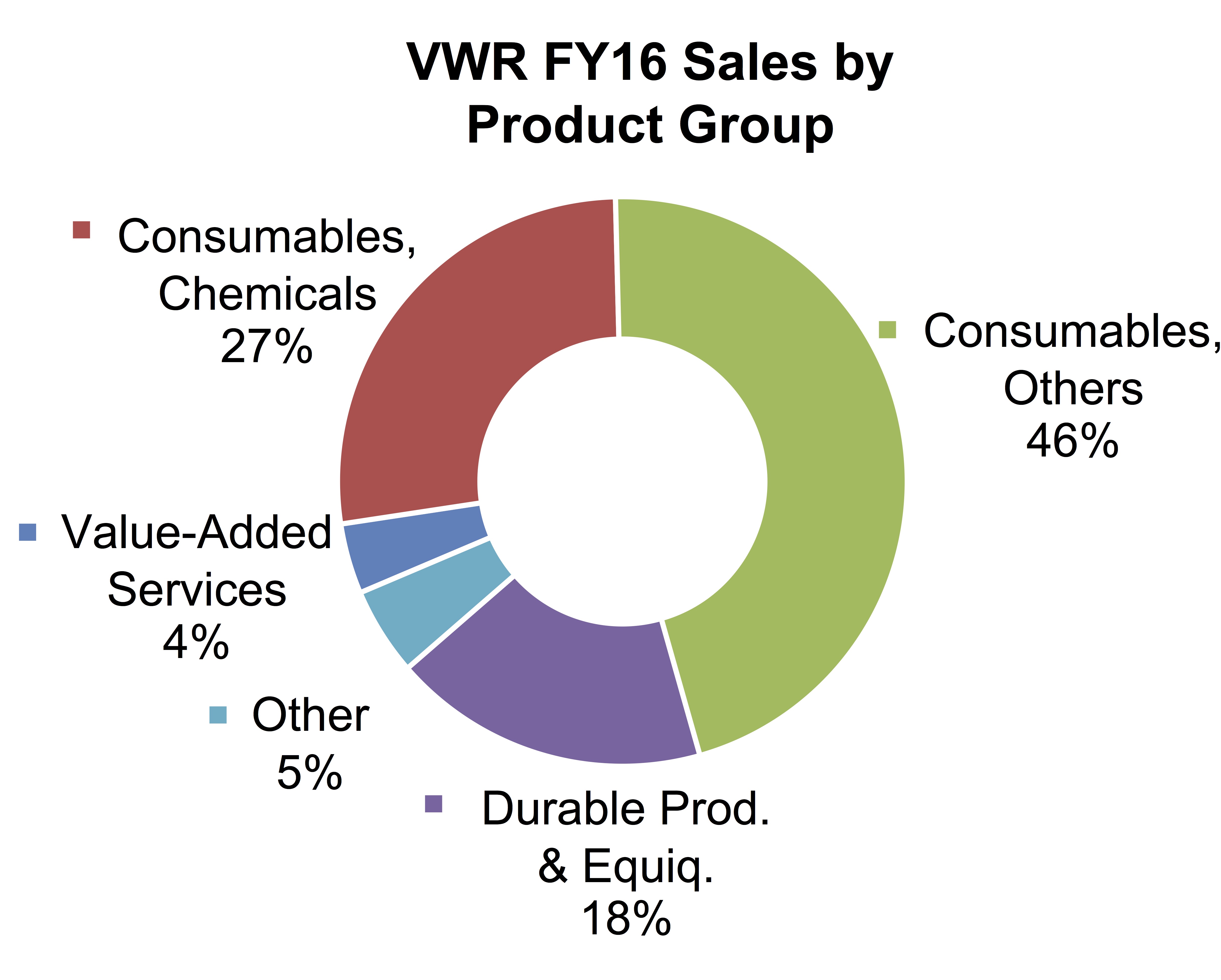Fourth Quarter 2016 Results: Pharma Stays Strong
Order Timing Limits Bio-Techne Growth
For the fiscal second quarter ending December 31, 2016, Bio-Techne sales advanced 9.0%, 2% organically, to $131.8 million. Sales were roughly in line with company expectations but were negatively impacted by lower OEM demand within the Diagnostics division.
Sales for the Biotechnology segment improved 2% organically, including low single-digit sales growth for proteins, and mid-single digits sales growth for antibodies and assays. The company highlighted demand for Novus antibodies especially through its web offering. Meanwhile, assay sales were aided by the expanded offering of Luminex instruments in addition to its consumables. However, this growth was partially offset by slower demand for PrimeGene due to China’s FDA regulatory changes, as well as a decline in large custom projects from US biopharmaceutical customers. On a standalone basis, sales for the acquired Advanced Cell Diagnostics (ACD) business (see IBO 7/15/16) climbed more than 50%.
Bio-Techne’s Protein Platforms segment continued its streak of double-digit organic growth as sales climbed 12%, including growth in all three major product categories: Western blot, multiplex ELISA and Biologics. Biologics sales advanced in the strong double digits, led by continued demand for the new iCE system, Maurice. While multiplex ELISA kit sales were slightly slower than previous quarters due to customer project timing, SimplePlex sales benefited from increased customer utilization, as cartridge sales grew roughly 50%. Finally, Western blot sales were boosted by Wes placements, which increased in the strong double digits to 72 units for a total installed base of 600 systems.
Diagnostics sales contracted 5% due to the uneven ordering pattern of OEM products, which were also impacted by the company’s assay offering with varying shelf life.
For the total company, which excludes the OEM diagnostic business, sales in Europe grew in the high single digits, including mid-teens and low single-digit sales growth from biopharmaceutical and academic customers, respectively. APAC sales maintained strength despite continued pressure on PrimeGene sales. Specifically, sales in China advanced in the mid-single digits, as lower PrimeGene sales was offset by double-digit sales growth for the Western product line. Japanese sales, which were flat, reversed a declining trend experienced over the last several years. Excluding China and Japan, Asia Pacific sales grew in the mid-teens, led by strength in South Korea.
US sales, which grew in the low single digits, slowed compared to the previous few quarters, especially from biopharmaceutical markets. While the company noted continued strength in biopharmaceutical orders for the region, average order size declined due to timing of projects.
Adjusted operating margin contracted nearly six percentage points as a result of acquisition and strategic investments. The company maintained its fiscal 2017 organic sales growth outlook of 6% or slightly higher. Fiscal third quarter organic sales growth for the Protein Platforms and Diagnostics divisions are projected to grow at a similar pace as the fiscal second quarter, while sales growth for the Biotechnology division is anticipated to accelerate.
Merck KGaA Q4 Growth Slows
Q4 2016
Fourth quarter 2016 sales for Merck KGaA’s Life Science division (LS) climbed 32.8%, 3.7% organically, to €1.44 billion ($1.55 billion = €0.93 = $1) to make up 38% of company revenues. The Sigma-Aldrich acquisition (see IBO 9/30/14) and currency contributed 28.8% and 0.3% to revenue growth, respectively. All sales figures below are based on organic growth.
Revenue growth for the LS segment experienced a sloping trajectory for the year as bioproduction demand decelerated in the fourth quarter 2016 due to delayed orders. Nevertheless, Process Solutions sales grew 4.1%, led by demand for single-use products and services. The Applied Solutions business recorded its strongest quarterly revenue growth for the year, advancing 6.0% due to demand for biomonitoring products in the EU and US. Sales for the Research Solution business slipped 0.6% organically, as strength in Europe and Asia were mostly offset by weakness in the US.
Geographically, LS sales in Latin American remained strong, climbing 13.3% organically.
Sales in Asia Pacific and Europe advanced 8.2% and 15.7%, respectively. Sales in the Middle East and Africa region improved 4.2%. Conversely, sales in North America contracted 11.1% because of political and budget uncertainties. LS adjusted operating margin slipped 29 basis points to 21.2%.
2016
Full-year 2016 sales for Merck LS climbed 68.6% to €5.66 billion ($6.29 billion = €0.90 = $1), including 63.1% growth from Sigma-Aldrich and currency headwinds of 0.8%. Organic sales expanded 6.3%, slightly above the company’s initial guidance, due to strength in biopharmaceutical markets and increased revenue synergies from the acquisition.
Process Solutions sales expanded 10.5%, led by global activity for large-molecule production and demand from developing biotechnology start-ups. Research sales grew 1.2% as growth was hindered by weak demand in North America. Applied Solutions sales climbed 4.3% due to strong demand of biomonitoring products to pharmaceutical customers and higher sales of analytical testing products.
Driven by strength within the Process Solutions business, LS European and Asia Pacific sales advanced 11.0% and 8.1%, respectively. Research Solutions sales also grew double digits in Europe. Sales growth in Latin America, as well as the Middle East and Africa climbed 12.7% and 6.9%, respectively. Applied Solutions sales were particularly strong in Latin America. Overall, North American sales contracted 1.3% due to slower academic demand.
LS adjusted operating margin expanded 248 basis points to 24.3% due to the acquisition. The company recorded annual cost synergies of €105 million ($116.7 million), roughly €15 million ($16 million) ahead of projections. In addition, revenue synergies are projected to increase, resulting in total synergies of €280 million ($300 million) in 2018. The company projected 2017 LS organic sales to continue to grow above the market rate.
Currency Magnifies Spectris Growth
Second-half 2016 sales for Spectris Materials Analysis (MA) jumped 22.4% to £243.3 million ($311.9 million = £0.78 = $1) to account for 32% of sales. However, currency and the acquisition of CAS Clean Air Service (CAS) boosted sales growth by 17% and 2%, respectively. Nevertheless, organic sales improved 3% compared to flat growth in the first half of the year.
Full-year 2016 MA sales similarly benefited from currency, as reported sales advanced 15.0% to £418.9 million ($566.1 million = £0.74 = $1) to account for 31% of revenues. Excluding currency and acquisition contributions of 12% and 1%, respectively, organic growth improved 2%.
Despite a strong comparison, pharmaceutical and fine chemical sales advanced on a currency-neutral basis, led by demand in China, India and Japan. Excluding currency, sales for this market were modestly higher in both North America and Europe. The acquisition of CAS further contributed to the company’s bioproduction growth.
Sales in metals, minerals and mining markets declined across most geographic regions except for Germany, the UK and Japan. Demand from cement and building materials customers in North America and Europe also slowed. However, the company noted positive aftermarket sales for safety and productivity applications to mining customers.
Academic research sales improved slightly, as positive growth in North America and Asia was partially offset by weakness in Europe and a sharp decline in the UK. Combined currency-neutral sales to the semiconductor, electronics and telecom industry improved at a strong rate due to significant growth in Asian regions outside of China and India. However, these markets experienced weakness in North America.
MA sales were driven by demand in Asia, for which sales grew roughly 13% excluding currency. Specifically, demand in China and Japan were particularly strong. Developed regions were challenged, as currency-neutral sales declined slightly in Europe and North America. Sales in Rest of World also declined, excluding currency.
Excluding currency, MA adjusted operating margin expanded 345 basis points to 18.2% as a result of product mix and restructuring actions.
VWR Growth Slows
Q4 2016
Fourth quarter 2016 sales for VWR improved 1.6%, 1.0% organically, to $1.13 billion. Acquisitions added 2.2% to sales growth, but were partially offset by currency headwinds of 1.6%. All sales figures below are based on organic growth.
The slower quarterly growth compared to the previous quarter was encumbered by a strong comparison and one less billing day. In addition, biopharmaceutical sales declined roughly 1% due to weakness for instrumentation in the US. Government sales, which grew roughly 3%, also slowed following a significant jump in the third quarter. Conversely, education and healthcare sales growth accelerated compared to the previous quarter, advancing roughly 1% and 5%, respectively. Industrial sales remained steady with growth in the low single digits, led by demand from food and environmental customers. By product, chemicals sales grew in the low single digits, while sales of equipment and instrumentation, and consumables were each roughly flat.
Sales for VWR’s Americas segment declined 0.9% due to one extra billing day in the previous year and a low single-digit decline in biopharmaceutical sales. However, healthcare and government sales climbed in the mid-single digits each, and sales to education and industrial customers improved in the low single digits each. By product, chemical sales grew in the mid-single digits, while consumables, and equipment and instrumentation sales each declined in the low single digits.
VWR’s EMEA-APAC sales advanced 3.6% organically, driven by strength in the industrial and healthcare markets, for which sales grew in the mid-single digits each due to sturdy consumables demand. Sales to biopharmaceutical, education and government customers increased in the low single digits each. Despite strength for private label products, growth within the biopharmaceutical market was hampered by lower demand from large pharma companies. Meanwhile, education and government sales both benefited from the timing of orders. By product, segment sales of consumables as well as equipment and instruments advanced roughly 5% each, and sales of chemicals improved roughly 2%.
VWR gross profit margin expanded 13 basis points to 27.8% due to product mix and improved pricing. Adjusted operating margin was roughly flat at 9.9%.
2016
Full-year 2016 sales for VWR expanded 4.5%, 3.2% organically, to $4.51 billion. Acquisitions contributed 2.5% to revenue growth, while currency headwinds reduced growth by 1.1%. Demand was again strong for the company’s private label products, and custom manufacturing and services, for which combined sales grew 8%–10% to account for 20% of revenues.
Despite slower biopharmaceutical demand in the second half of the year, such sales climbed roughly 5% to account for 45% of revenues. Healthcare and government sales each grew in the 4% range to make up 7% and 5%, respectively. Accounting for 22% of sales, industrial revenue advanced roughly 3%. Education sales, which represented 14% of revenues, declined in the low single digits.
By product, chemicals sales grew in the strong mid-single digits, while sales of consumables as well as equipment and instruments advanced in the low single digits each.
Sales for VWR’s Americas and EMEA-APAC segments climbed 3.0% and 3.4% organically to account for 61% and 39% of revenues, respectively. Gross margin improved 23 basis points to 28.0% due to higher pricing and product mix. Adjusted operating margin was unchanged at 9.5%.
Sales for 2017 are projected to grow 1%–2%, 2.5%–3.5% organically, to $4.56–$4.61 billion. By end-markets, organic sales in the biopharmaceutical markets are expected to grow in the mid-single digits, and advance in the low to mid-single digits in the industrial markets. Government sales should remain steady in the Americas but constrained in the EMEA-APAC segment. Healthcare demand is also expected to be pressured in the EMEA-APAC segment but strong in the Americas. First quarter organic sales growth is projected to be lower than the annual rate due to a strong comparison.








